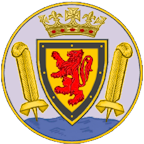Early History
Little is known of the ancient history of Saltash, but there is some evidence that the area was settled at a very early date. Less than 150 years ago there was a 'longstone', or menhir, at or near the top of the hill where Saltash town now stands, and various flint implements (such as skin-scrapers and arrow-heads) from the period 4,000 to 1,500 BC have been found in fields around the town. As flint is not found locally, there seems to have been at the least some trading across the Tamar, making it likely that there was a crossing point nearby.
At the narrowest point of the Tamar Estuary, with a natural beach mirrored on the other side of the water and protected at the upstream end by Ashtorre Rock protruding into the estuary, Saltash is a natural crossing point which would have been far more suitable for landing than the areas of mud further upstream, and it is believed that there has indeed been a crossing here since earliest times.
There are no visible signs remaining of a pre-Norman settlement in the vicinity of the crossing, but there was certainly a Roman earthwork a mile east of the crossing on the Devon side, and there seems to have been a Roman road running through the Plymouth area and into Cornwall, so it is likely that there was a ferry across the Tamar during the Romano-British period. If so, there may well have been a small settlement close to the crossing, possibly on the site of the present day Tamar Street, lived in by fishermen and the ferrymen. The steep hillside rising from the river would have been readily defensible and was well supplied with water from various springs, so there may well have been a prehistoric fortification in the area.
After the Roman departure from Britain, the isolated enclosed farmsteads of Cornwall were replaced by unenclosed farms whose names begin with the Brythonic 'tre-', meaning 'homestead'. Saltash Civil Parish includes Trevollard, where there are traces of a Celtic field system, Trehan, and Trematon. One of the earliest local settlements for which we have evidence is the village of Trematon ('Tre-' and 'matern', meaning 'king') – around the 7th century, it was a Celtic tribal capital, a place of some considerable importance.
At the beginning of the 8th century the Cornish still observed Easter on the dates that their Celtic church had calculated, at variance with the more recent Roman Catholic practice. King Geraint of Cornwall's refusal to conform to the standards of Rome led, in the year 710, to armed conflict against King Ine of Wessex at the Battle of Linig, which seems to have taken place between the River Tamar and the River Lynher. Subsequently the lands between the two rivers ("twenty hides by the Tamar: to wit, Linig") were granted to Glastonbury by Royal Charter.
Saxon settlement and land charters over the next two hundred years left their mark on the area: between the Lynher and the Tamar there are today many more English than Cornish place names. During this period the now-dominant Saxons established the Manor of Trematon, which included part of today's Pillaton parish and an area around the ferry landing on the east bank of the Tamar, as well as the present-day parishes of Saltash and Botusfleming – about 3,000 hectares (7,000 acres) in total.
The Saxon King Athelstan, who ruled during the first half of the 10th century, is reputed to have had a castle on the high ground at Forder, where Trematon Castle now stands. King Athelstan fixed the eastern boundary of Cornwall at the east bank of the Tamar but, as the rulers of Wessex were by now the undisputed overlords of Cornwall, this change made no real difference to the local inhabitants.
Brictmer, a very rich and important Saxon noble, held the Manor of Trematon during the reigns of Edward the Confessor and Harold Godwinson, but he was dispossessed when Saxon rule ended with the Norman Conquest. In 1066 Brian of Brittany, who is said to have commanded a band of Bretons on the western flank at the Battle of Hastings, became the Lord of the Manor.
page updated 2025-03-21
